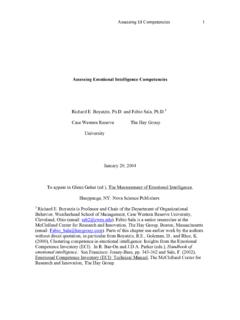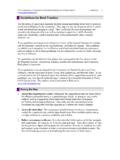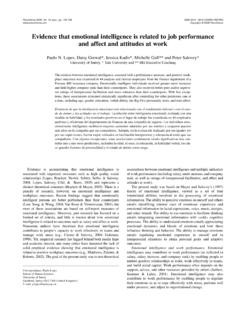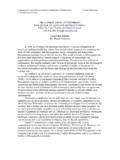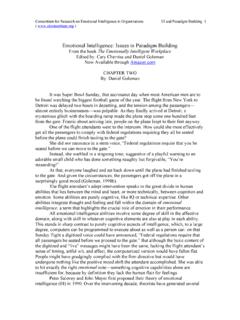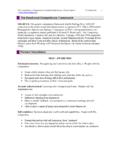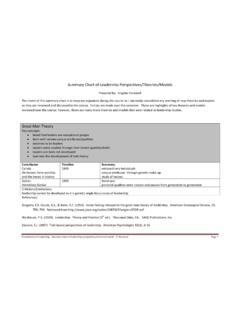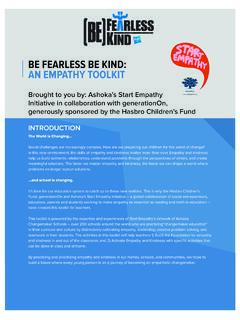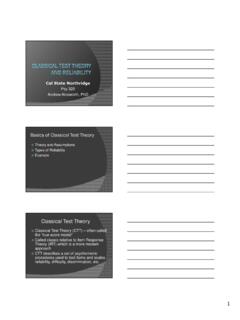Transcription of EQ and the Bottom Line: Emotional Intelligence Increases ...
1 EQ and the Bottom Line: Emotional Intelligence Increases IndividualOccupational Performance, Leadership andOrganisational ProductivityGeetu Bharwaney, Reuven Bar-On and Ad le MacKinlayEQ and the Bottom Line: Emotional Intelligence Increases IndividualOccupational Performance, Leadership andOrganisational ProductivityGeetu Bharwaney, Reuven Bar-On and Ad le MacKinlayFirst published in the UK byEi World Limited4 Doolittle Mill, Ampthill, Bedfordshire MK45 2 NDTel: +44-1525-840090, Fax: +44-1525-840092, Email: Web: Bharwaney, Bar-On & MacKinlay 2007, 2011 First Published 2007, Reprinted 2011 by Ei WorldThe rights of Bharwaney, Bar-On and MacKinlay to be identified as the authors of this work have been asserted bythem in accordance with the Copyright, Designs and Patents Act rights reserved.
2 Except as permitted under current legislation no part of this work may be photocopied, storedin a retrieval system, published, performed in public, adapted, broadcast, transmitted, recorded or reproduced in anyform or by any means, without the prior permission of the copyright Library Cataloguing-in-Publication DataA catalogue entry for this paper is available from the British 978-0-9556184-0-6 Printed in the UK by:MBE MaidenheadDesigned by Cobalt Graphic Design LtdAll information current at time of going to print. The authors and Ei World Limited cannot be held responsible forany information that is inaccurate. The views on Emotional Intelligence are the authors' own, based on their workand experience in the field of Emotional EQ-i and EQ-360 are trademarks of MHS. Page NoTable of ContentsOverview 1 Section1:The Emergence, Definition and Measurement of Emotional Intelligence 2 1.
3 The emergence of Emotional Intelligence 2 2. Defining and measuring Emotional Intelligence 3 3. The Bar-On model of Emotional Intelligence 5 Section 2:The Empirically Based Evidence for Applying Emotional Intelligence in the Workplace 7 1. The impact of EI on occupational performance 7 2. The impact of EI on leadership 8 3.
4 The impact of EI on organisational productivity 9 Section 3:Applying Emotional Intelligence in the Workplace 10 1. How to approach the application of EI in order to maximise organisational productivity 10 2. Pre- and post-intervention EQ assessments 11 3. A case study demonstrating organisational impact of an EI intervention 12 Appendices 19 Appendix A: Practitioner's Glossary of Basic Psychometric Terms 21 Appendix B: Reliability 22 Appendix C: Construct Validity 23 Appendix D.
5 Predictive Validity 24 References 25 Contributors' Biographies 27 About Ei World Limited 35EQ and the Bottom Line 1 2007, 2011, Bharwaney, Bar-On, MacKinlay.
6 For permission to reproduce please contact Ei World Limited email: and the Bottom Line: OverviewEQ and the Bottom Line: Emotional Intelligence Increases IndividualOccupational Performance, Leadership andOrganisational ProductivityGeetu Bharwaney, Reuven Bar-On and Ad le MacKinlay OverviewThe primary objective of this paper is to show that the development of Emotional Intelligence increasesoccupational performance, leadership and organisational productivity. We will briefly explain what Emotional Intelligence (EI) is, how it is measured, why it is important andhow best to apply it in the workplace to maximise organisational productivity. Studies will be describedthat demonstrate the Bottom line impact of EI interventions, and a case study will be presented toillustrate the design, business relevance and impact of a specific organisational paper is written specifically for HR professionals so that they will be better informed and, thus,feel more confident in influencing key stakeholders in the implementation of EI programmes, processesand The emergence of Emotional entelligenceEmotional Intelligence (EI) has become a very pop-ular topic since the publication of a bestseller bythe same name in October 1995 [Goleman].
7 Al-though the construct of Emotional Intelligence isnot new, its application in the workplace, designedto increase individual performance and organisa-tional productivity, has begun at a rather frenziedpace during the past decade. The precursors ofthese efforts extend back to the post Second WorldWar era with extensive surveys conducted by theUnited States Office of Personnel Managementand with the pioneering work of David McClellandat Harvard University that focused on the impor-tance of emotionally and socially intelligentbehaviour among the heightened level of interest in this 'new'idea, scholars have actually been studying thisconstruct for the greater part of the twentiethcentury, and its historical roots can be traced backto the nineteenth century [Darwin, 1872/1965].
8 Incontrast to these scholarly efforts, many recentarticles in the popular HR and business press haveserved to dilute the importance and relevance ofemotional Intelligence . Additionally, there are veryfew sources of information which have attemptedto bring together a wide range of pertinent EIbusiness data that is directly applicable in theworkplace. This paper is a response to the scarcityof practical EI knowledge and is hoped to startreversing this unfortunate next section of this paper defines EI andpresents a scientific approach to describing andmeasuring it. We will then present a number ofkey findings that demonstrate why this constructis especially important and valuable in the work-place. The studies discussed will provide empiricalevidence of the Bottom -line impact of and the Bottom Line 2 2007, 2011, Bharwaney, Bar-On, MacKinlay.
9 For permission to reproduce please contact Ei World Limited email: and the Bottom Line: Section 1 Section 1:The Emergence, Definition and Measurement of Emotional IntelligenceThis section of the paper introduces the emergence, definition and measurement of the concept of emotionalintelligence (EI). The Bar-On model will be explained as a key approach to defining, describing andmeasuring this concept. This section is designed to 'whet the appetite' of those who are new to the field ofemotional Intelligence , while the seasoned EI practitioners will find it to be a helpful Defining and measuring Emotional intelligenceIn the 'post-Thorndikean modern' period, theefforts to define and eventually measure thisconstruct began with the work of Gardner onalternative forms of Intelligence [1983], continuedwith Bar-On's idea of an "EQ" that began during thesame period, and became very focused withSalovey and Mayer's seminal publication on" Emotional Intelligence " [1990] followed byGoleman bestseller that publicised this wholearea [1995].
10 During the past decade in particular,significant research activity has focused onaddressing the question of how best to defineand measure EI. Various approaches have beenproposed, and a number of different conceptu-alisations of this construct have appeared, creatingsome degree of confusion regarding the best way todefine, measure and apply Emotional clarify this situation, theEncyclopedia of AppliedPsychology[Spielberger, 2004] suggests that there arecurrently three major EI models: a) the Bar-On model [1997b] which describes this construct as an array of interrelated Emotional and social competencies, skills and facilitators that impact intelligent behaviour, measured by self-report [Bar-On, 1997a] as well as multi-rater or what is also referred to as 360-degree assessment [Bar-On & Handley, 2003a, 2003b].


